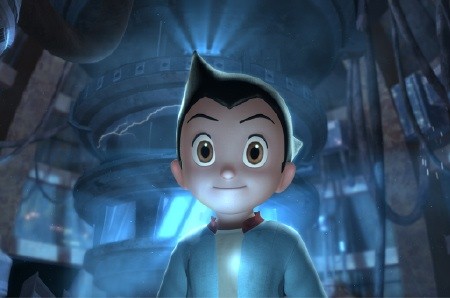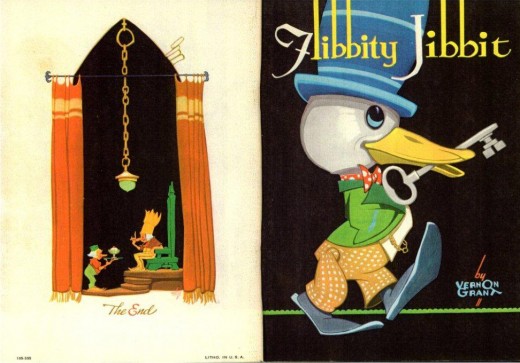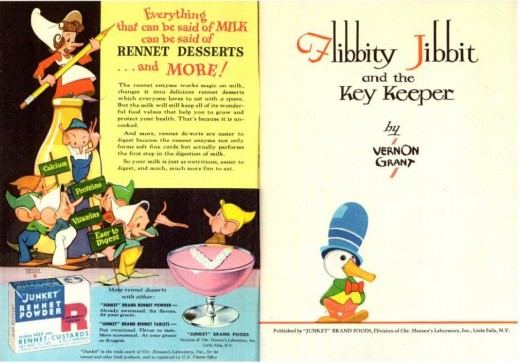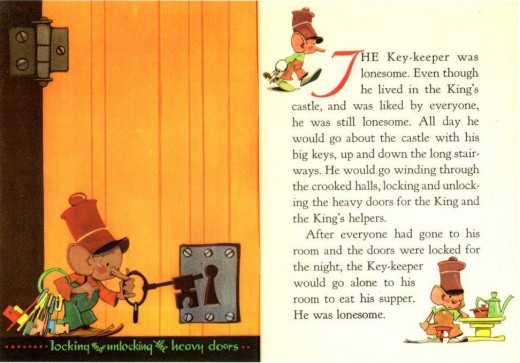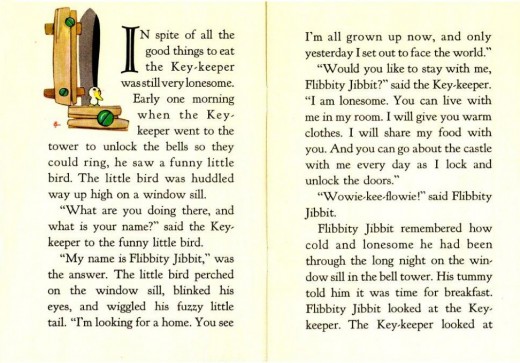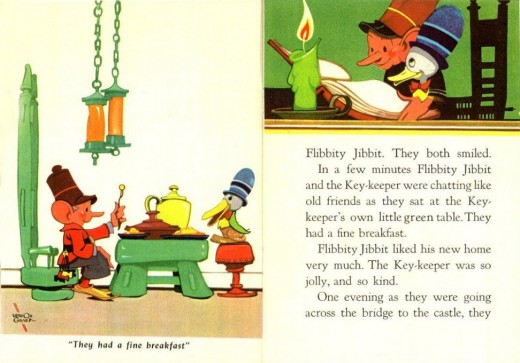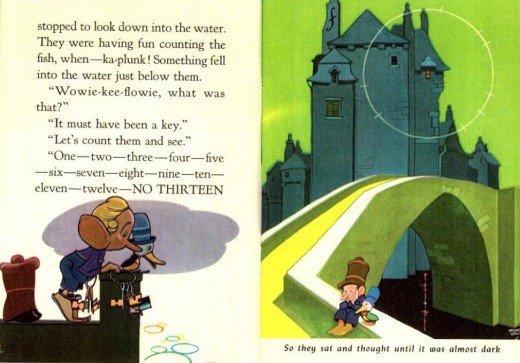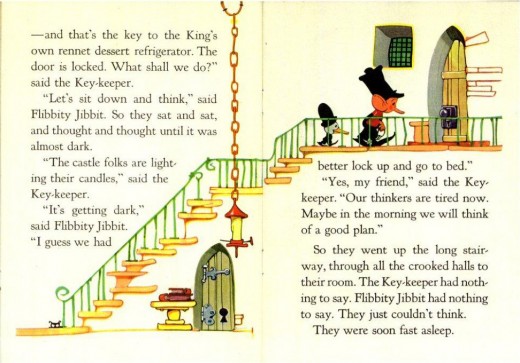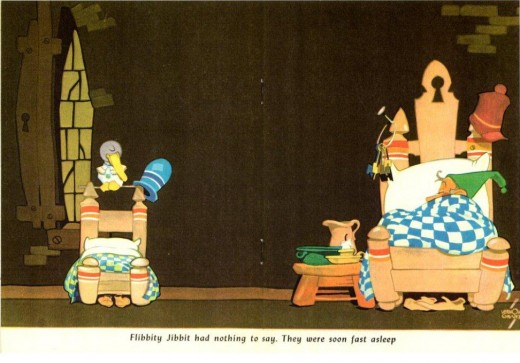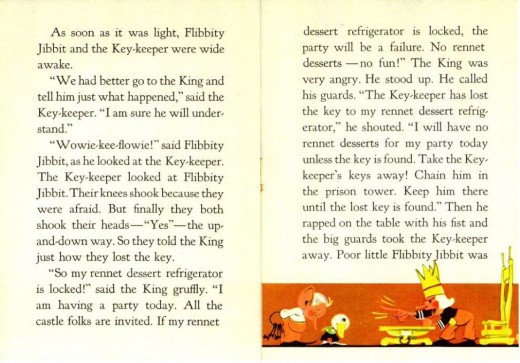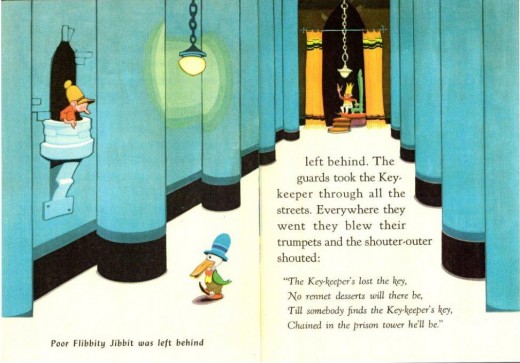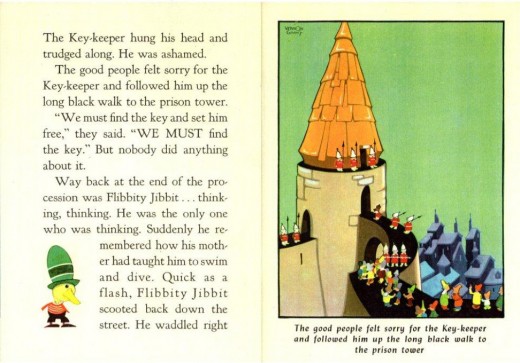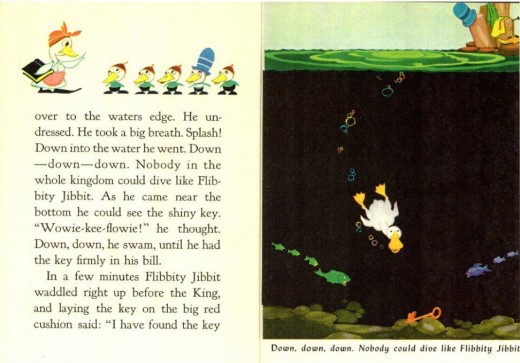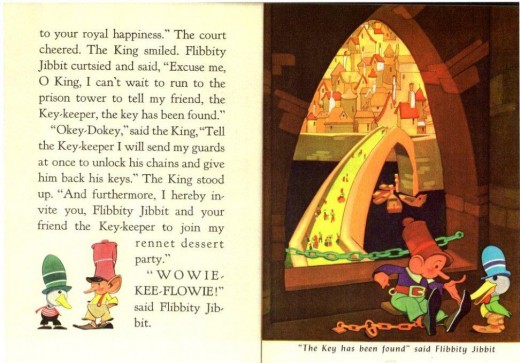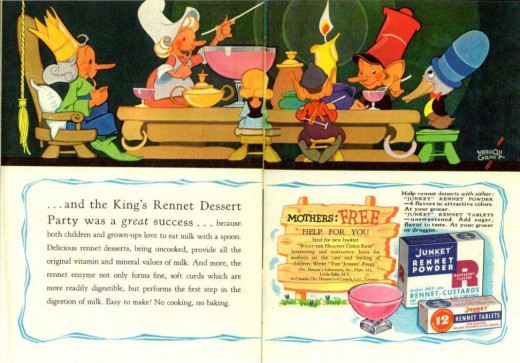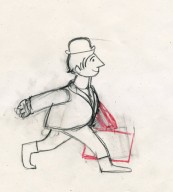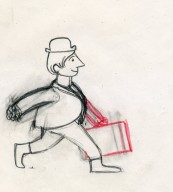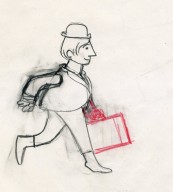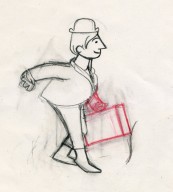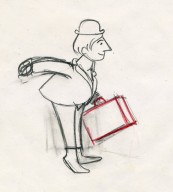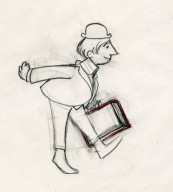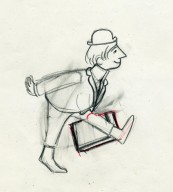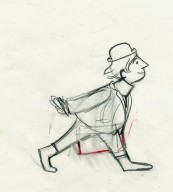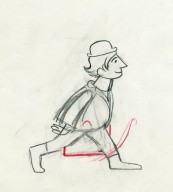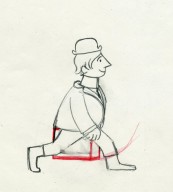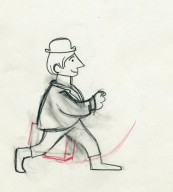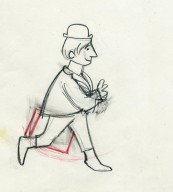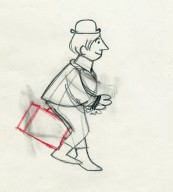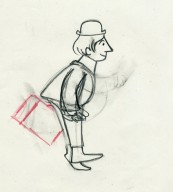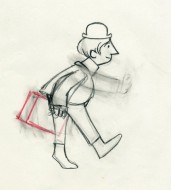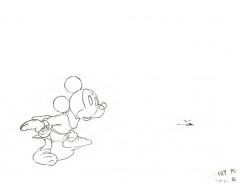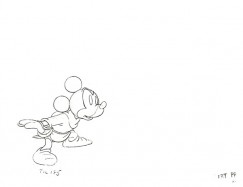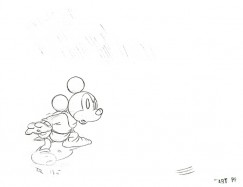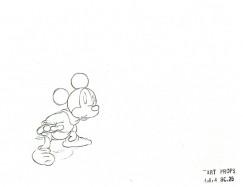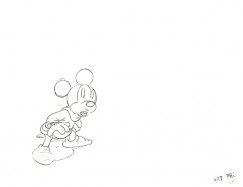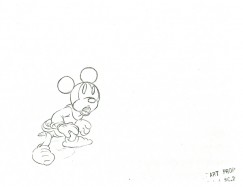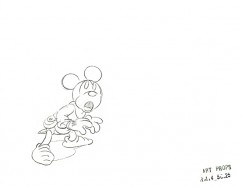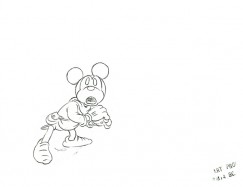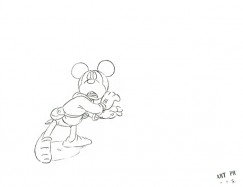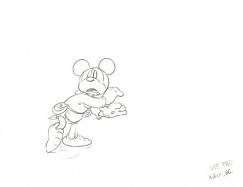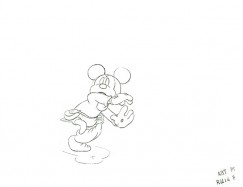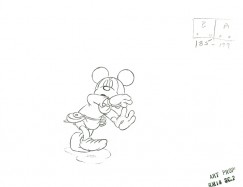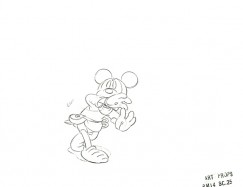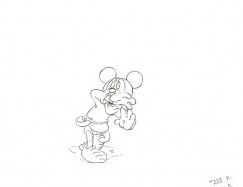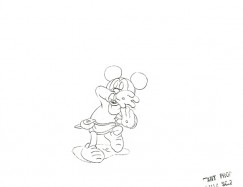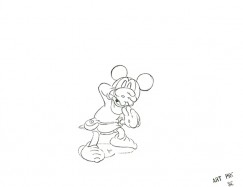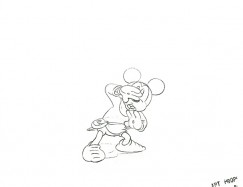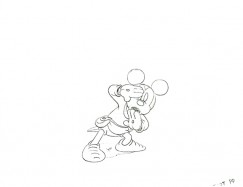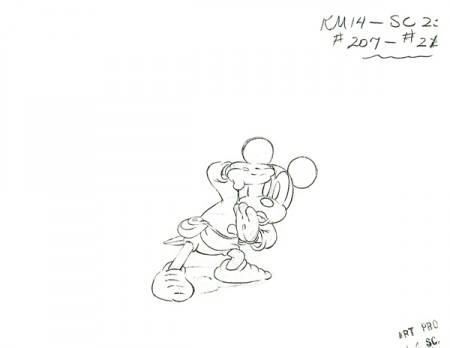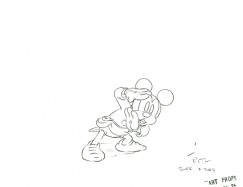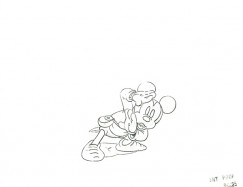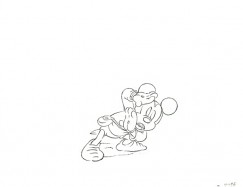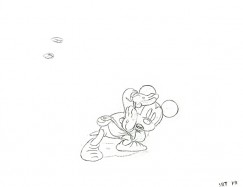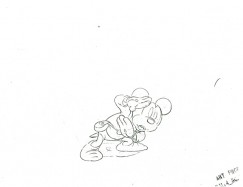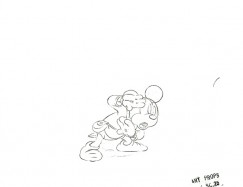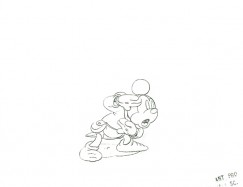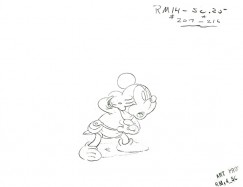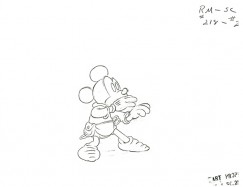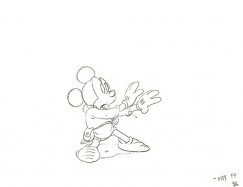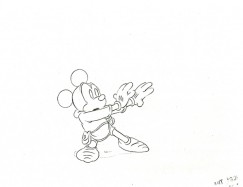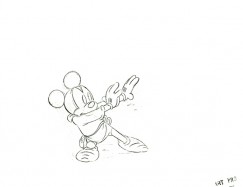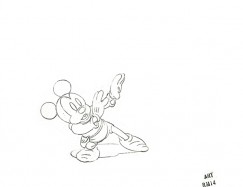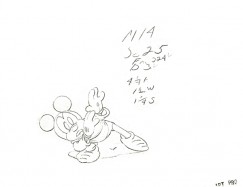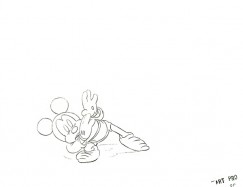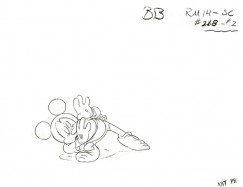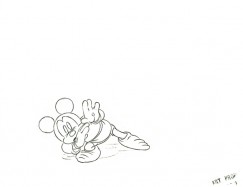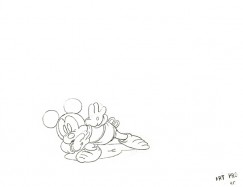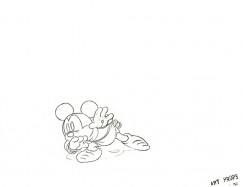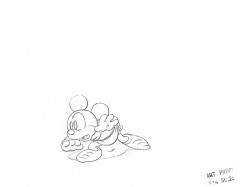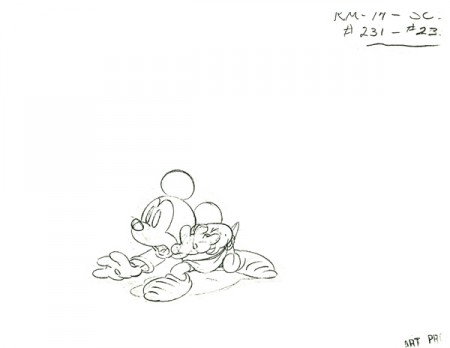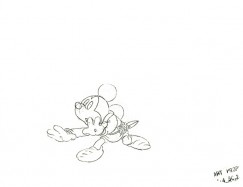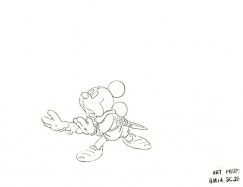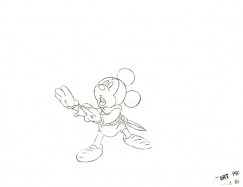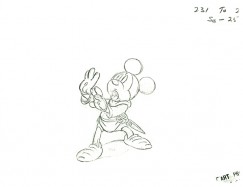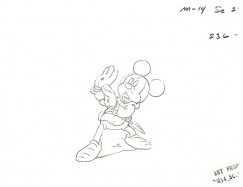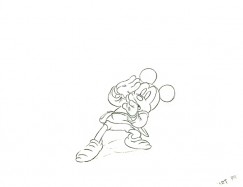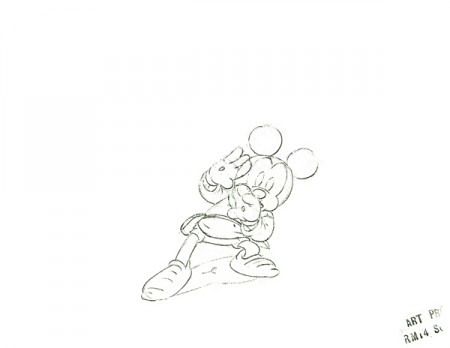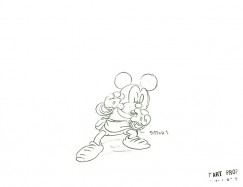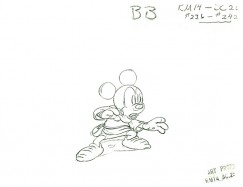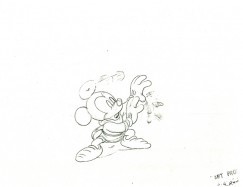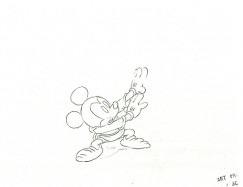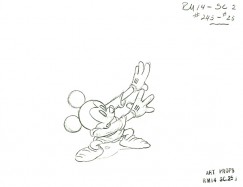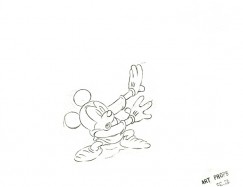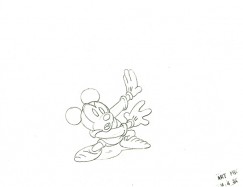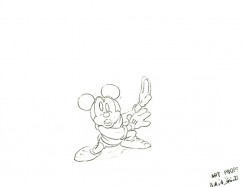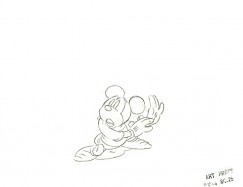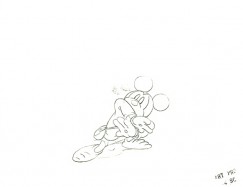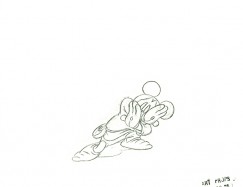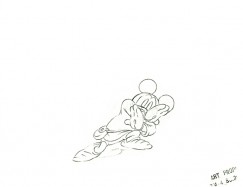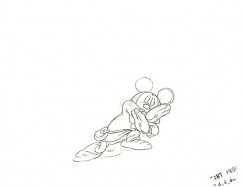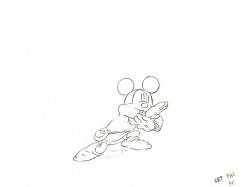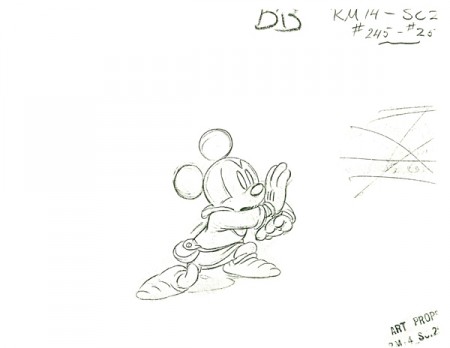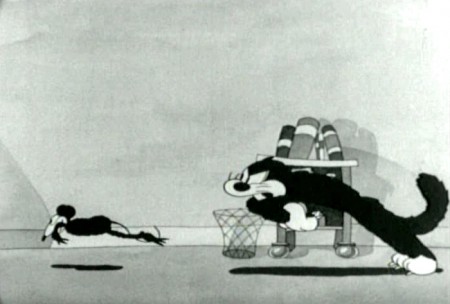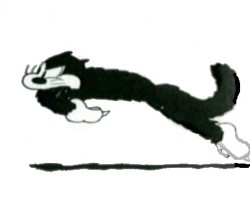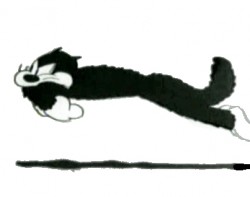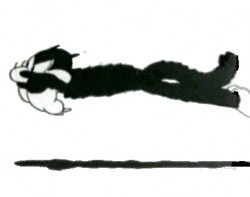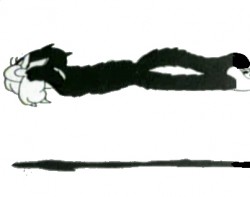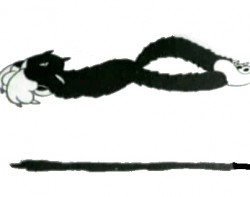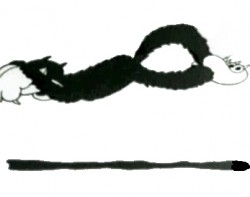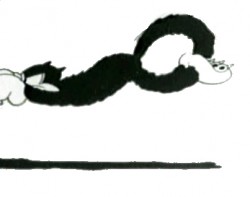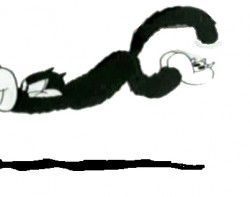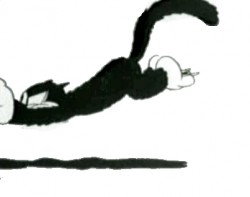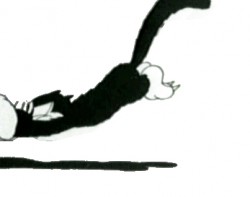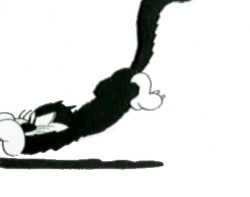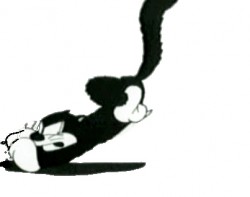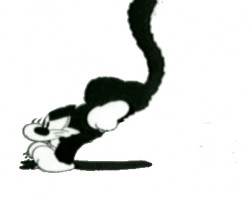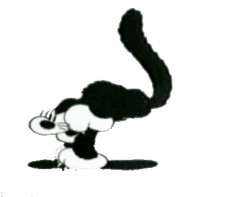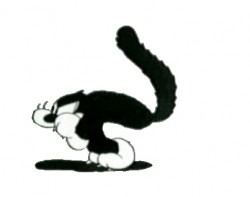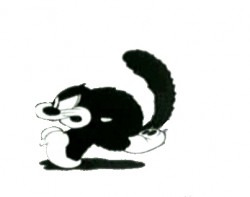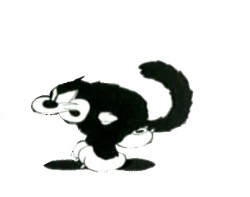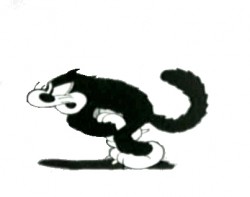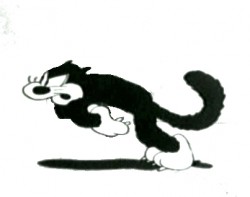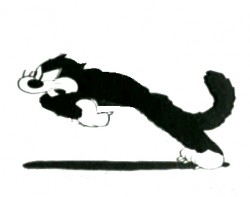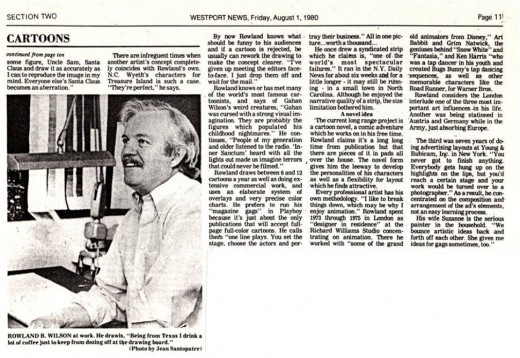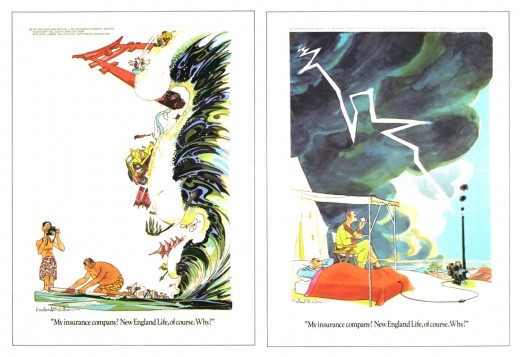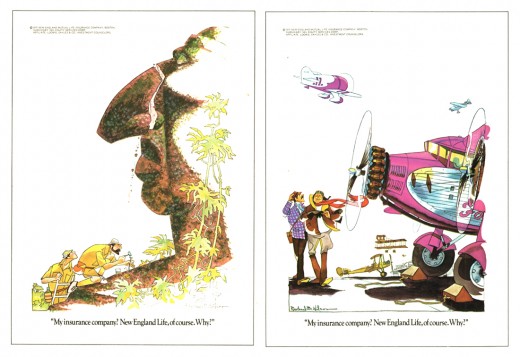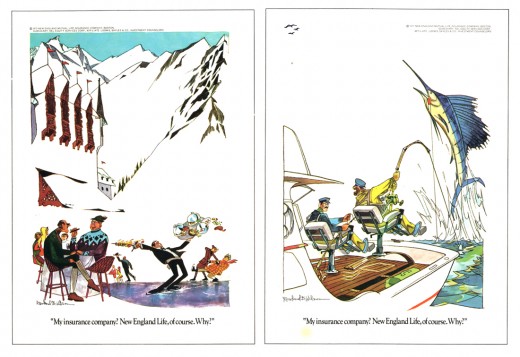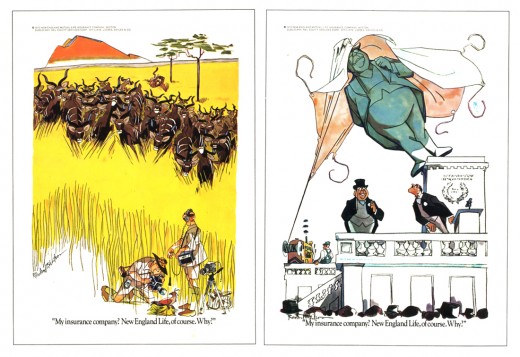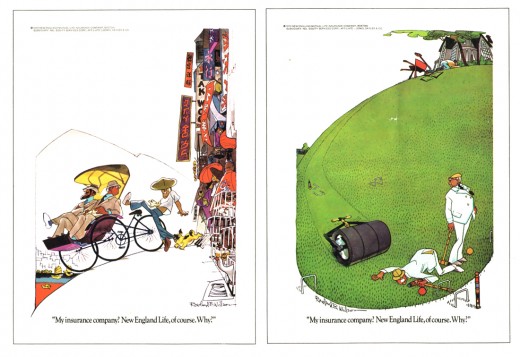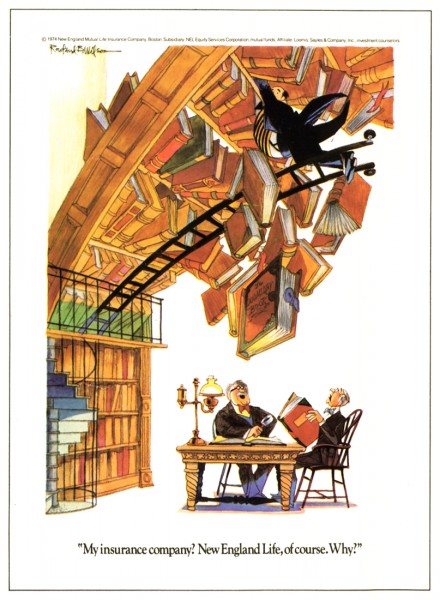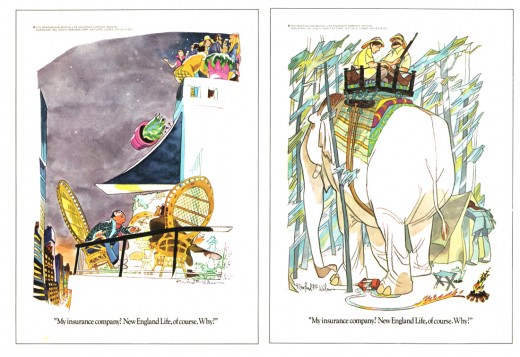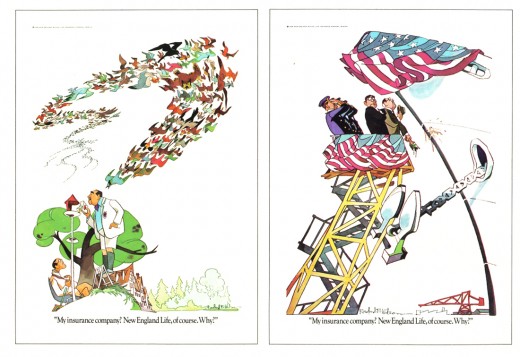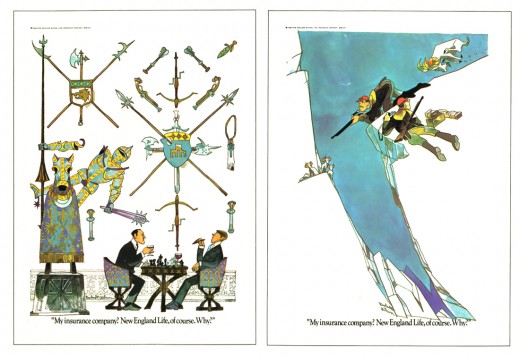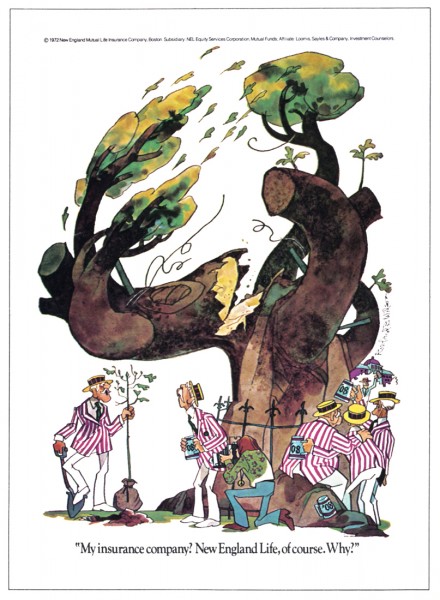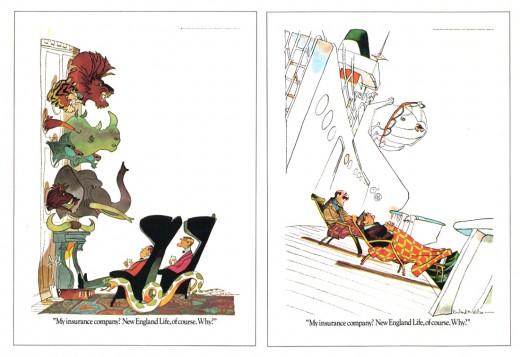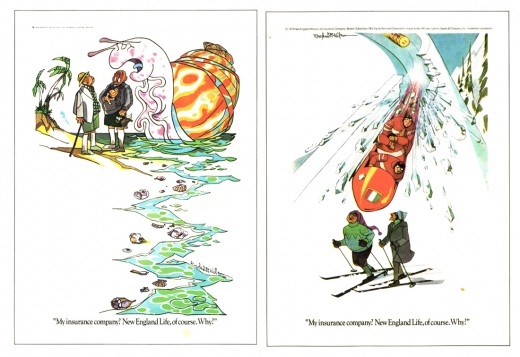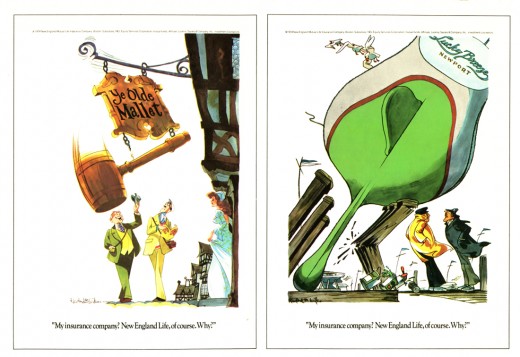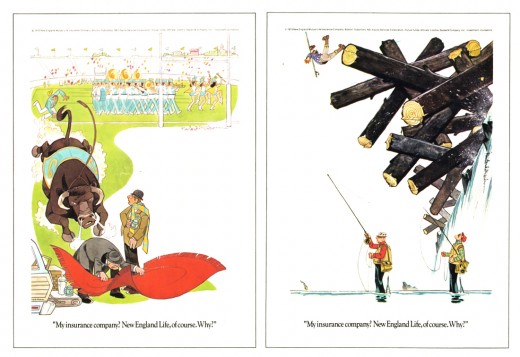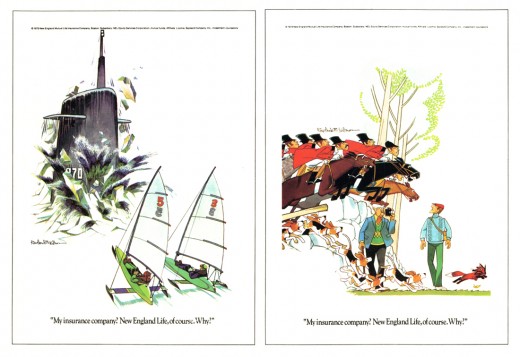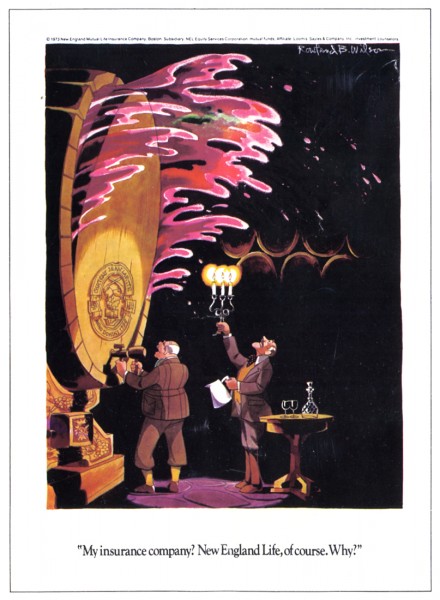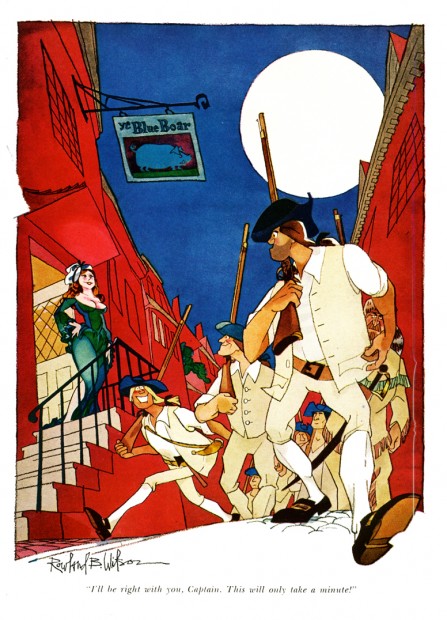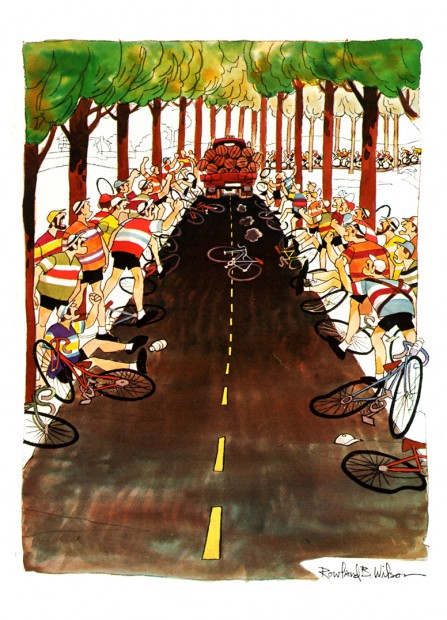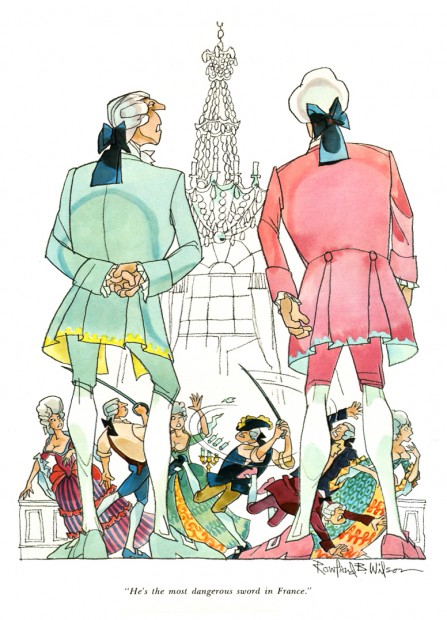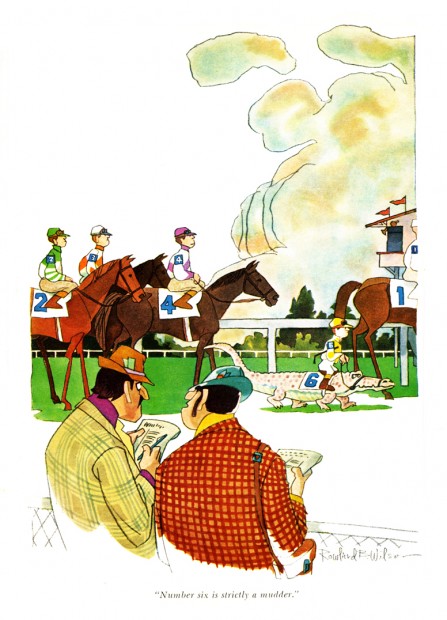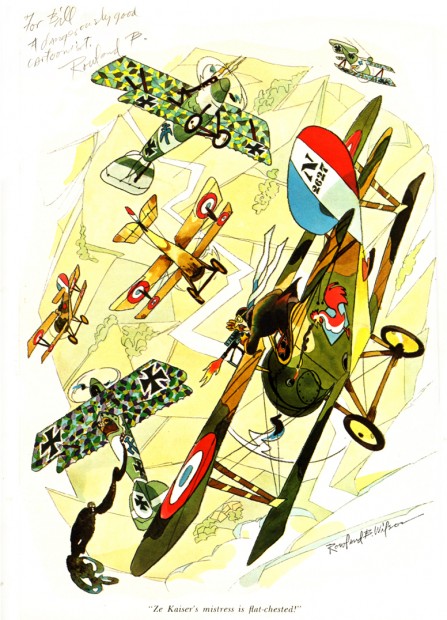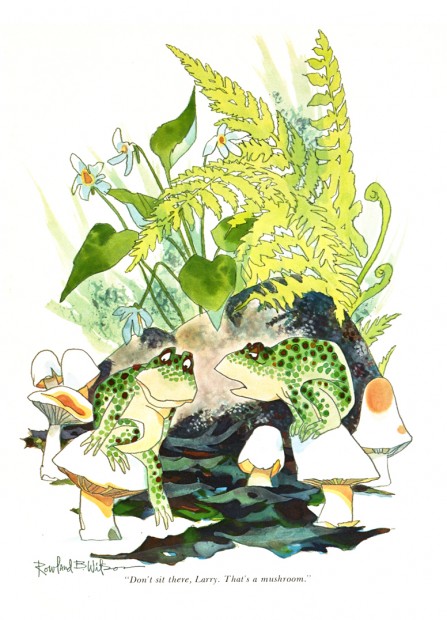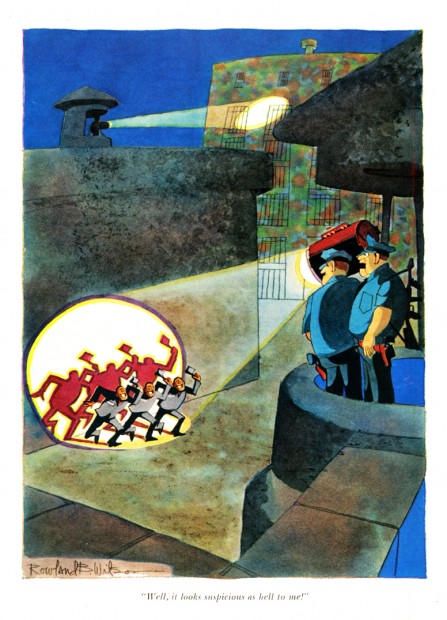Monthly ArchiveMarch 2010
Commentary 21 Mar 2010 08:10 am
Outta Biz Photo
- In case you were wondering what happens to old animation studios, I thought I’d post this flyer I received in the mail yesterday. It arrived just in time for the release this week of the Astroboy DVD.
 1
1(Click any image to enlarge.)
Not a pretty site. All those cubicles (on pg. 3) were once filled with people manipulating images of Astroboy and Ninja Turtles. Now they’re just piles of objects to be sold. Perhaps another adventurous producer will buy it all to start a new production.
But then, I was searching to see if there was a tilted desktop pictured in the whole. Of course not. Lots of G5s though. Wonder if they have any software on them.
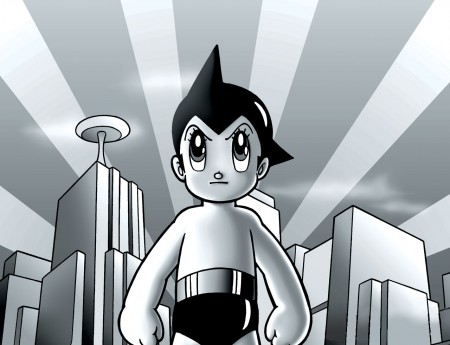
Oh wait. Not that one.
At least, it’ll live on in DVD.
Bill Peckmann &Illustration 20 Mar 2010 08:13 am
Vernon Grant’s Flibbity Jibbit
- I’ve posted two pieces by illustrator, Vernon Grant, the designer of Snap, Crackle and Pop. Here’s a booklet out of the hands of the late Rowland B. Wilson. I start with a short note sent to Bill Peckmann (who graciously loaned the material for display. Many thanks.)
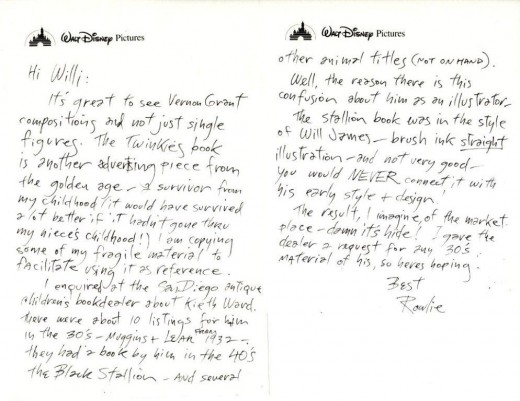
(Click any image to enlarge.)
The other three Vernon Grant posts can be found here:
Snap Crackle Pop
Vernon Grant’s Nursery
Vernon Grant’s Santa Claus
Articles on Animation &Bill Peckmann &Daily post 19 Mar 2010 08:30 am
Animation Overview – 1976
Here’s another survey of the year in animation for the March/April issue of Print Magazine circa 1976. Leonard Maltin did the surveying. Interesting that you don’t see many of this type article anymore.
Overview
by Leonard Maltin
British animator Bob Godfrey has said, “Animation is a medium that deserves masters worthy of it. I’d like to see animation Picassos or Matisses, and we haven’t had any so far.”
Of course, Matisse never had to raise two million dollars in order to create one of his paintings, and Picasso didn’t have to oversee a staff of inkers and painters to make sure his newest canvas would turn out right.
The artist who chooses animation as his medium must endure certain realities: that films cost money, that extensive filmmaking becomes expensive filmmaking, and that except for the most monastic souls filmmaking is a collaborative process. This is not to eliminate the possibility of individual artistic expression in animation, but there are simpler ways known to man.
Once the artist has made his film, another set of realities comes to the fore: trying to find a distributor, or at least an audience, and with any luck, establishing a way of recouping the monetary investment of making the film. Since individual backing is hard to come by, to examine “the state of the art” of animation is to examine “the state of the industry” at the same time; it’s nearly impossible to separate the two.
In this country—as around the world— animation means so many different things that even the most cursory observations can expand to extreme lengths. “Animation” covers a lot of ground, from high-school kids filming paper cutouts with a Super 8mm camera to major Hollywood factories turning out Saturday morning drivel by the carload, but there are some significant outposts along the way.
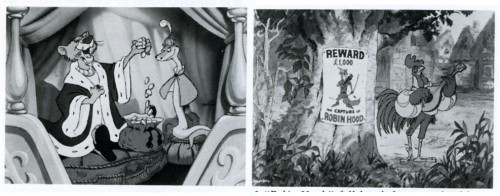
“Robin Hood” full length feature produced by Walt Disney Prods.
Producer/Director Wolfgang Reitherman
Rumors of the Walt Disney Studio’s abandonment of cartoons are greatly premature. There was a time several years ago when the future of animation at the studio was in doubt, but the whopping worldwide success of the animated Robin Hood is just one reason that animated features are an ongoing project in Burbank.
The studio’s current endeavor is The Rescuers, which concerns two detective mice who head a society of do-gooders. Like other recent Disney features, it will comprise some four years of work— anywhere from three to four times as much as most competitors spend on similar projects. Rescuers is being aimed for Christmas of 1977, but there’s no guarantee that it will be completed on time. No one rushes this group of craftsmen.
The two main objectives in any Disney feature are a strong story line, the backbone of the film, and equally strong personality development, which gives the film its heart. Unfortunately, the approaches to these objectives have become increasingly routine in the 1960s and 70s at Disney, with much of the personality emanating from big-name stars doing character voices, and not so much from the animator’s pencil, although character animation is still superbly handled.
Practically everyone working on The Rescuers in a major capacity has been at the studio for 30 to 40 years, and Frank Thomas, a senior member of the team, admitted to John Canemaker, “We are less experimental. [With Walt] every picture was completely different. We were always pushed into things that were exceedingly difficult to do. He was always asking us to rise above ourselves. Well, when he left it up to us, we quit that. We got old. We decided we were going to do the things that were fun to do.”
The quality is still there, and the years of care and precision that go into a Disney feature show up on the screen. But somehow, the magic is missing, and that has nothing to do with time or money.
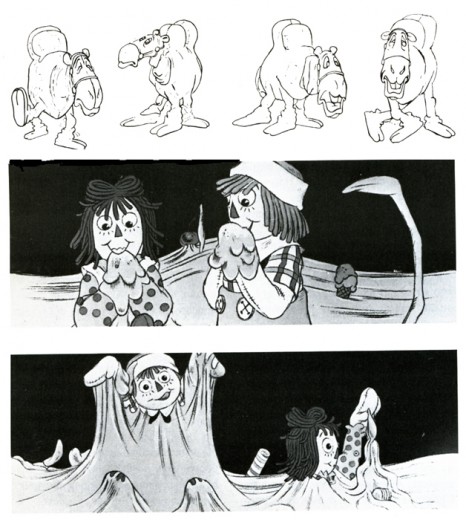
“Raggedy Ann & Andy” upcoming feqture based on Johnny Gruelle’s characters.
Production company: Lester Osterman Prods. Supervisor/director: Richard Williams
Into the breach steps a young man who has been hailed as “the new Disney,” Richard Williams. Canadian-born, British-based, he has impressed the animation world with his main titles for feature films (Charge of the Light Brigade, Return of the Pink Panther), theatrical shorts (“Love Me, Love Me, Love Me”), television specials (A Christmas Carol), and commercials.
The comparison with Disney is apt, because Williams has devoted himself tirelessly to the improvement of his work. Several years ago he began recruiting veteran Hollywood animators to come to London and work with his staff, as artists-in-residence, teachers, and colleagues. These men, in their 60s, 70s, and 80s, have all contributed to Williams’ pet project, an animated feature entitled The Cobbler and the Thief, which has been in progress for the better part of a decade. Williams and his people work on this when there is time, between commercial assignments. Among the distinguished Disney, Fleischer, and
Warner veterans who have pitched in are Art Babbitt, Shamus Culhane, Grim Nat-wick, and Ken Harris. It’s a two-way love affair, a happy collaboration between men of age and experience and younger animators with fresh ideas and outlooks.
Now Williams is hard at work on an ambitious American project, a musical feature version of Raggedy Ann and Andy set for release at Christmastime this year. He has gathered a hand-picked staff in New York and supplemented it with freelancers from places as far off as Arizona.
Oher animated features are also on the way. It took Fritz the Cat to convince distributors and theater-owners that animated films shouldn’t be regarded as kiddie-show fodder and nothing more. Now John Hubley is directing a cartoon version of the bestseller Watership Down, while Fritz’s director, Ralph Bakshi, is working on his fourth feature film (the third, Hey, Good Lookin’, is about to be released). Producer Lee Men-dohlson and director Bill Melendez are working on a third Peanuts feature in California, while a New York operation has completed a feature-length remake of Tubby the Tuba. Other features are in production and planned for the near future.
But feature films tell only part of the story. Many filmmakers, amateur and professional, work in the realm of short subjects, and bringing these to the attention of an audience, not to mention a distributor, can be a long and wearisome process. One splendid showcase is the annual awards competition sponsored by the New York branch of ASIFA, the international animation society. Their recent screenings of this year’s winners revealed much about trends, goals, and styles in current films.
In the Student Film Category were three astoundingly professional products: Eduardo Damino’s “Hello,” a slick, imaginative treatise on the history and impact of telephones, using colorful cutout animation and an abstract soundtrack; Stephen Ciodo’s “Cricket,” a finely crafted stop-motion film for children about a cricket who is ostracized by his peers because he’s unable to jump; and Linda Heller’s “Album,” a most intriguing series of vignettes based on flashbacks and flash-forwards in a photo album of a woman’s life.
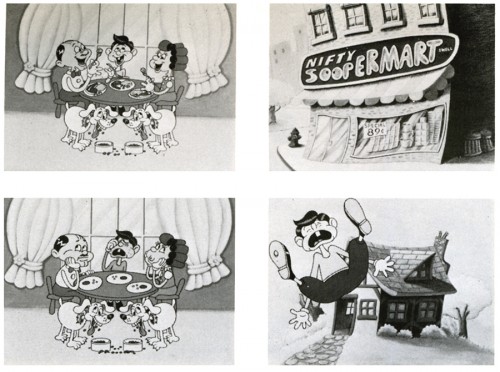
“A Dog’s Life” Due to soaring food prices, a family eats less while their dogs eat more.
Production company: Perpetual Motion Pictures | Producer: Marshall Patinkin
Director/designer: Hal Silvermintz | Animator: Vince Cafarelli
A vital category for prizes at ASIFA East is the Non-Sponsored Professional Film. Chapter president Dick Rauh explains that this category is intended to encourage members to take the time to make personal films, apart from their daily assignments; indeed, the five winners showed a wide range of highly individual styles and goals.
Mary Beams’ “Going Home Sketchbook” has an interesting visual concept, combining sketches, line animation, and what seems to be a rotoscope technique to create an impressionistic view of a trip home; unfortunately, there is no development within the film to give it any real interest beyond that technique. “Deep Sleep” is a feminist-oriented film by Peggy Tonkonogy that details a woman’s long, weird symbolic dream; again, an aimless-ness is somewhat compensated for by excellent visual effects. Both of these films received Honorable Mention.
George Griffin’s “L’Age Door” is an irresistible film that perfectly meshes form and content as a man is confounded and swallowed up by an endless succession of doors. Short, sweet, and quite funny. Griffin’s film won Third Prize in this category.
“Quasi at the Quackadero,” Second Prize-winner, is one of the most bizarre animated films I’ve ever seen. Sally Cruickshank’s visual extravaganza bears repeated viewings, just to absorb everything that’s happening on-screen; the style might be described as freaked-out George Herriman. Significantly, Cruickshank labels her film “a cartoon,” showing strikingly-designed characters attending a futuristic amusement park where the games and rides are based on time- and life-warps.
First Prize was awarded to Kathy Rose for her quiet and enjoyable film “The Doodlers,” the basic premise of which is that drawings beget drawings.
In the general categories, awards were divided according to soundtrack, technique, script/concept, humor, design, animation, and direction. Most of these were commercial and/or sponsored films, including several delightful commercials from Phil Kimmelman and Associates, a funny NBC “Weekend” gag-film by Ovation Films, some dazzling 7-Up graphic spots by Goldsholl Associates, and two fine shorts by the Wantu Studio headed by the talented James Simon.
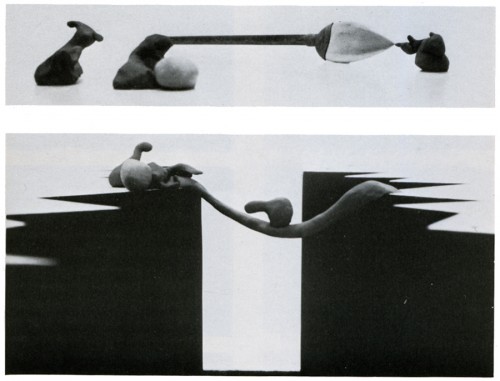
“Whazzat” Clay figure animation based on blind man and the elephant
Sponsor: Encyclopedia Britannica |Production company: Crocus Pictures
Producer: Tel C. Determan | Director: Art Pierson
Awards for Best Animation and Best Direction went to Arthur Pierson and his associates Ron Lasner and Alan Baker for a disarming stop-motion clay film called “Whazzat?” (which had already won Spe-cialJury Prize for Best Film at the New York Animation Festival). The premise of “Whazzat?” has six clay objects assuming vivid personalities, although they have no faces or identifying features; together, they travel and enjoy each other’s companionship, until they come upon a strange being unknown to them. Through sophisticated and knowing animation, camera placement, and ingenious use of soundtrack, “Whazzat?” makes something special out of something elegantly simple.
Best Film in ASIFA’s competition was another repeater from the New York Festival, Stan Phillips’ “Water Follies,” produced as a soft-sell promotional film for the Denver Water Commission. An entertaining series of blackout gags on uses and abuses of water, this straightforward film quietly goes about its business and scores a bull’s-eye with its entertaining point of view and uncluttered animation style.
One may be hesitant to accept the idea of slick, professionally sponsored films competing with more personal, individual works. But the ASIFA screening brings out something very important about animated films. They come from individuals and they come from large companies; they range from utter simplicity to overstuffed detail, from quietude to clutter. But each film stands on its own, with its own set of goals to be met, and if it fails, all other considerations become worthless.
Not every professional film is better than an amateur effort. There are films made by eight- or nine-year-olds which burst with imagination and daring visual ideas; they put some professional filmmakers to shame. Likewise, some one-minute TV commercials are so outstanding in every respect (animation, design, humor) that they overpower more “serious” artistic works shown alongside them.
But does the film succed on its own terms? Be it Disney, Bakshi, commercial or collegiate, that’s the only question that really counts.
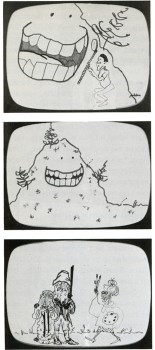 1
1 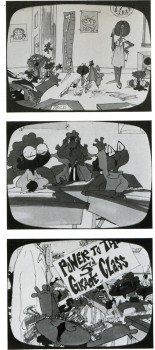 2
2 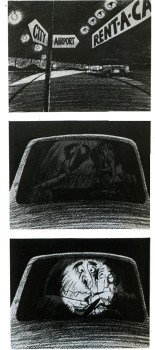 3
3
1.”Teeth Care” Sesame Street – Prod/Dir: James Simon Animator: Jack Schnerk
2. “The Strike” Morris Funk Foundation Prod/Dir: James Simon
Animators: Cosmo Anzilotti, Lu Guarnier, Ed Smith, Sal Faillace
3. “I Want My Avis” Prod Co: PK&A | Prod: Hal Hoffer
Designer: Mordi Gersteion | Animator: Jack Dazzo
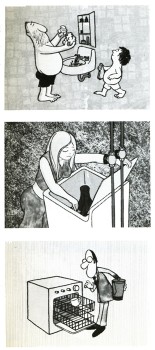 4
4 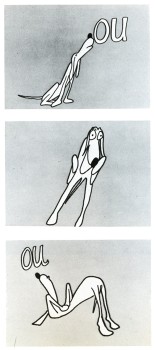 5
5 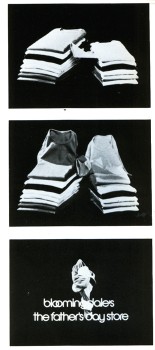 6
6
4. “Water Follies” Sponsor: Denver Water Dept | Prod/Designer: Stan Phillips
5. “Ou Hound” CTW | Prod/Dir/Anim: John Strawbridge
6. “French T-Shirts” Bloomingdales | John Gati Film Effects
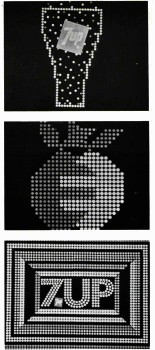 7
7 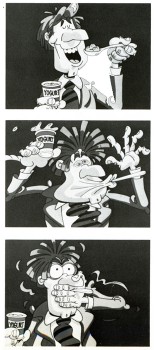 8
8
7. “Carton Graphics” 7-up | Goldscholl Associates
Designer: Morton Goldscholl Dick Greenberg
8. “No More Puckers” Yoplait Yogurt | PK&A producer: Sid Horn
Director: Phil Kimmelman | Designer: Bill Peckmann | Animator: Lu Guarnier
Leonard Maltin teaches the history of animation at the New School for Social Research, New York City, and is author of The Disney Films, among other movie books. He is currently guest programmer for the Museum of Modem Art’s “Salute to Film Comedy.”
Commentary &Disney 18 Mar 2010 08:39 am
Waking Sleeping Beauty
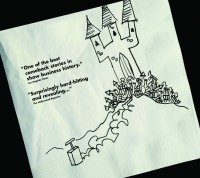 - Waking Sleeping Beauty is a tightly edited documentary detailing the years between 1984 and 1994 at the Disney Animation Studio. From The Black Cauldron through The Lion King. There’s ample footage of the artists in meetings – particularly story meetings, goofing around and walking the halls of the old Animation building on the Disney lot.
- Waking Sleeping Beauty is a tightly edited documentary detailing the years between 1984 and 1994 at the Disney Animation Studio. From The Black Cauldron through The Lion King. There’s ample footage of the artists in meetings – particularly story meetings, goofing around and walking the halls of the old Animation building on the Disney lot.
Yet the story being told – without an iota of fat – is the story of the above-the-line players and how they felt about each other. The machinations and power plays they work on each other to wrest control and credit for the studio’s success is the primary interest of this film, not the attitudes and thoughts of the animation people.
Only a couple of times do we really get to imagine how the artists felt about what was going on. There’s a meeting called by Katzenberg to talk about how the people felt about the period. They explained that they weren’t able to spend appropriate time with their families because of all the excess overtime that was demanded of them. Katzenberg tears up and promises that things will get better. They don’t; things get worse.
Throughout the film is colored with home movie footage taken by Randy Cartwright of a lot of the animators and artists mugging for the camera. The only shot that gives an inkling that something serious is going on is a shot where Tim Burton is caught at his drawing board, and he literally doesn’t know what to do. Frustration, irritation and annoyance beams off his face. It was one of the biggest laughs for the audience surrounding me. There are ample and tight closeups of many of these people: Tom Sito, Andreas Deja, Eric Goldberg, Joe Ranft, Roger Allers, Mike Gabriel and many more. Yet, none of them – NONE – are labelled and identified.
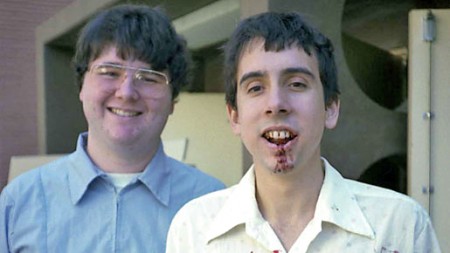
Joe Ranft and Tim Burton still don’t recieve identification in this film.
Yet their images are known by many outside the industry.
Yet, every executive gets clear identification. Even the full list of end credits runs alongside running footage of people/artists in the studio saying hello and playing for the camera. Yet, none of these people are identified. I’m not even sure their names appeared in the credits since it was hard to watch the running type while trying to see the archival footage.
Despite this complaint, the story told was engrossing. Since I can identify most of the people, I was also absorbing every frame of the home movies and the footage shot for PR sake that also filled the film.

Howard Ashman and Alan Menken are given the due credit for both The Little Mermaid and Beauty and the Beast and, to some extent, Aladdin. Ashman, as we know, had a lot to do with the shaping of both films. I’d already given credit to him for much of the guidance of the two films, so it was good to see the filmmakers support this. In many ways, in my mind, a great deal of credit for this renaissance fell on his shoulders.
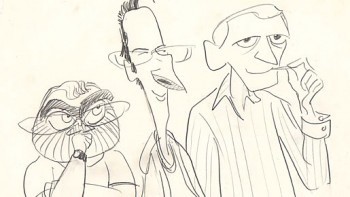 In fact, I’m surprised, given the enormous success the studio has had over the years with Alan Menken’s songs and music, that they didn’t bring him in for The Princess and the Frog. Menken brought good luck to so many of the animated features of this period that one wonders if it may have helped. Given his successful track record, there was more likelihood that he might have brought something to the film. They were trying to reboot their musical franchises, yet they turned to Randy Newman – who’d been hit and miss for them at Pixar. Perhaps the Pixar connection gave Newman the upper hand with John Lasseter, probably finalizing that decision.
In fact, I’m surprised, given the enormous success the studio has had over the years with Alan Menken’s songs and music, that they didn’t bring him in for The Princess and the Frog. Menken brought good luck to so many of the animated features of this period that one wonders if it may have helped. Given his successful track record, there was more likelihood that he might have brought something to the film. They were trying to reboot their musical franchises, yet they turned to Randy Newman – who’d been hit and miss for them at Pixar. Perhaps the Pixar connection gave Newman the upper hand with John Lasseter, probably finalizing that decision.
The film includes newly recorded interviews with many of the higher salaried artists which overlapped some of the footage and helped to move the story. Eisner, Katzenberg or Roy Disney are also seen in detailed comments taken from press releases, all of which underlines the lust for power over the animation studio. The fever pitched competition between Disney and Katzenberg is certainly highlighted.
Don Hahn directs the film with assuredness, and he acts as the primary narrator – though, producer, Peter Schneider‘s high-pitched comments certainly color the film as well.
It’s a tense and serious attempt to record a POV of one very successful period at the Disney studio, and to a great extent they get it. However, since it is made by two people in a position of power, their interest is definitely focussed on the four people above them – Eisner, Disney, Katzenberg and Wells. To be honest, I’m not sure the drama would have held if you’d concentrated on the people below their level. However, I do think the artists deserve at least to have been identified.
It’s a very entertaining film for those interested in animation and Disney, in particular.
The film opens in four cities on March 26th: NY, LA, SF and Chi. You can see it at the Landmark Sunshine theater in NY.
Animation &Hubley &Tissa David 17 Mar 2010 08:10 am
Expanded Upkeep Cycles Recap
Two years ago, I posted part of this piece which included the drawings. I’ve expanded it and added the QT so you could see how it moves.
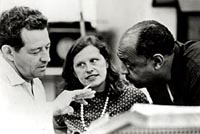 – Back in 1973, the Hubleys produced Upkeep, a short film for IBM. It chronicled the history of the service repairman in a light hearted way. Actually an industrial, it was treated like a personal film. (There’s a thin line between some of their industrials and their personal films.) Of Men and Demons was done for IBM though they considered it a personal film; it instructed in the positive aspects of the binary code and was nominated for an Oscar.
– Back in 1973, the Hubleys produced Upkeep, a short film for IBM. It chronicled the history of the service repairman in a light hearted way. Actually an industrial, it was treated like a personal film. (There’s a thin line between some of their industrials and their personal films.) Of Men and Demons was done for IBM though they considered it a personal film; it instructed in the positive aspects of the binary code and was nominated for an Oscar.
___(John & Faith Hubley with
___composer, Benny Carter) ______Tissa David did the lion’s share of the animation for ______________________________Upkeep. Phil Duncan, Lu Guarnier and Jack Schnerk were the other key animators on it. Helen Komar and I assisted all of them, and I inked the whole film. Gen Hirsch and I colored it. John did all the Bg’s.
The initial animation on the service man was done by Phil Duncan. Tissa had to pick up the character, and she found the walk Phil had done so funny that she kept it throughout the film adding shades and tones to it as she thought appropriate.
The art was inked with a sharpie, bled with thinner, then colored with magic markers. Each drawing was then cut out and pasted to cels. Hubley’s Bg’s followed the same style: sharpie on board, washed & bled with thinner, added watercolor washes.
Posted below are the drawings for that 18 drawing walk cycle.
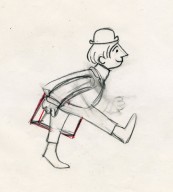
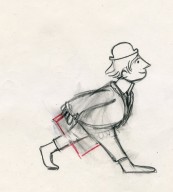
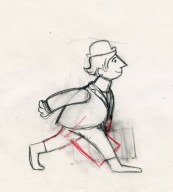
(Click any image to enlarge and view whole animation page.)
Note: this meant that the BG was designed to pan on two’s as well.
To run QT click on the left side of the black bar below the image.
To run one frame at a time, click the right side of the bar.
Now, excuse my driving a point home for the fifth time. Please observe that the feet are on two different planes. The two feet do not hit the same horizon line; one is drawn behind the other, consequently it’s drawn slightly shorter.
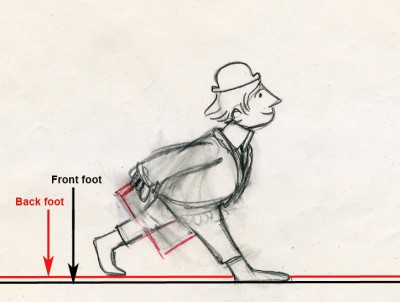
Most students today (if they actually draw both legs animated instead of repeating 1/2 of the cycle over and over) have both feet touching the same line on the horizon.
Commentary 16 Mar 2010 07:52 am
Haiti and other stuff
- I received the following film in an email from Karl Cohen in San Francisco. Karl writes: “Alan Sperling is a former employee of Richard Williams when he had a studio in LA and has worked in SF for many years.”
In fact Alan also animated on Cool World, Toy Story, and Monsters Inc.
He did the following film, Scratch, for the Haitian relief effort and he’s just trying to get it seen by as many people as possible. So take a look, if you haven’t seen it as yet.
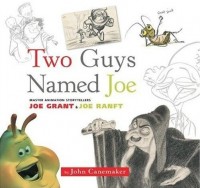 - Recent posts about the internet toast the 50th birthday of the late Joe Ranft.
- Recent posts about the internet toast the 50th birthday of the late Joe Ranft.
I think the most fitting tribute for this man will come later this year when John Canemaker‘s beautifully written and sensitive book, Two Guys Named Joe arrives in book stores. The stories of Joe Ranft and Joe Grant are detailed, elaborated and interrelated without an iota of sentimentality. This is a gorgeous and strong book and a magnificent tribute to both Ranft and Grant. It’s one of the best books in John’s canon. Look for it in August.
 Speaking of Joe Ranft, I saw a screening at MOMA last night of Waking Sleeping Beauty, a must for any animation enthusiast. It’s a fast paced intriguing story when all layed out. I’ll review the film later this week. I just wanted to mention that Joe Ranft was featured prominently (though never identified) throughout the film. He, obviously, was a big part of that period.
Speaking of Joe Ranft, I saw a screening at MOMA last night of Waking Sleeping Beauty, a must for any animation enthusiast. It’s a fast paced intriguing story when all layed out. I’ll review the film later this week. I just wanted to mention that Joe Ranft was featured prominently (though never identified) throughout the film. He, obviously, was a big part of that period.
I also got to meet Tomm Moore, who sat in front of me, at the screening. I’m pleased to finally be able to put a face to The Secret of the Kells. I’ve seen the film twice and have a lot of respect for the enormous production he was able to pull off so successfully. It’s so hopeful for all of us independents to see the little guy with so tiny a distributor making such large waves.
- Other sites talk about the press release this past week of Disney’s closing Imagemovers Digital, the company Robert Zemeckis used to make his last couple of MoCap features. This was hardly great news given the costs that those films absorbed. When the Jim Carrey Christmas Carol costs $174 million, it’s unlikely to return its investment. Ultimately, it will probably break even, but one wonders if the same financial “success” wouldn’t have been achieved using traditional animation. When Bolt costs $150 million and returns $114 from US receipts, it’s averaging about the same as the $50 million loss Christmas Carol currently shows. Beowulf had a $150 million budget and brought in $82 million.
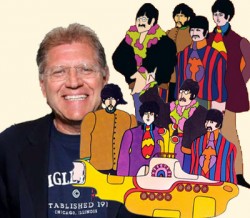 It seems clear to me that the writing was on the wall. The wonder is that Disney still has the deal to release The Yellow Submarine. Undoubtedly that film will ignore the great graphics of the original to bring us a MoCap version of the four Beatles – in that wonderful Zemeckis “walking-dead” style. How much can that lose – and cost?
It seems clear to me that the writing was on the wall. The wonder is that Disney still has the deal to release The Yellow Submarine. Undoubtedly that film will ignore the great graphics of the original to bring us a MoCap version of the four Beatles – in that wonderful Zemeckis “walking-dead” style. How much can that lose – and cost?
Remember, a bad movie is a bad movie, whether it’s traditionally animated like Treasure Planet or cgi like Space Chimps or MoCap like Beowulf. Disney’s not moving away from financing bad movies, they’re cutting costs on financial risks.
- For those of you not living in New York, this is the kind of outdoor advertising Adult Swim uses to promote its wares.
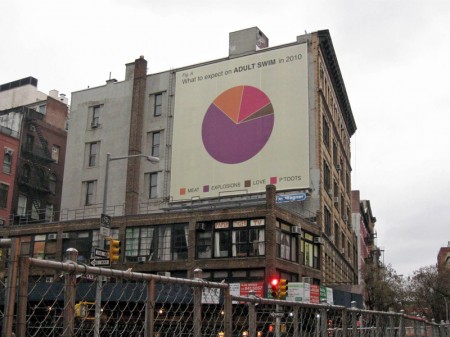
.
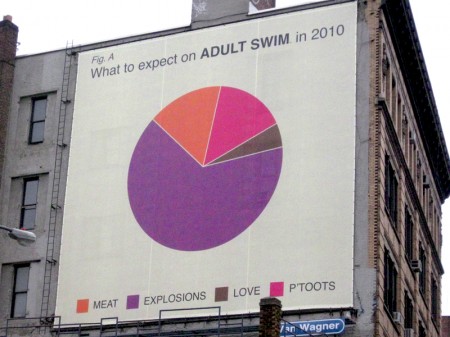
.
Almost as good as the shows themselves. 25% P’Toots.
________________
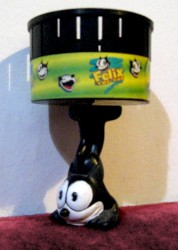 - Finally, I wanted to revisit something Amid Amidi posted on Cartoon Brew over the weekend. Brian Duffy wrote to me to introduce me to a couple of sites. As an enormous fan of optical toys, with a mini collection of non-authentic pieces of my own, I rushed to look at the wares on the site, the Richard Balzer collection. There, I loiotered for hours and have returned many times since first viewing them. Everyting from Praxinoscopes to Thaumatropes to Zoetropes are displayed in a stunning collection of artifacts in this wealthy collection. They also have a blog, dickbalzer.blogspot.com, which is demonstrating via flash videos how the pieces operate. I look forward to viewing some of the zoetrope animations and will continue to return for updated pieces. I love this stuff.
- Finally, I wanted to revisit something Amid Amidi posted on Cartoon Brew over the weekend. Brian Duffy wrote to me to introduce me to a couple of sites. As an enormous fan of optical toys, with a mini collection of non-authentic pieces of my own, I rushed to look at the wares on the site, the Richard Balzer collection. There, I loiotered for hours and have returned many times since first viewing them. Everyting from Praxinoscopes to Thaumatropes to Zoetropes are displayed in a stunning collection of artifacts in this wealthy collection. They also have a blog, dickbalzer.blogspot.com, which is demonstrating via flash videos how the pieces operate. I look forward to viewing some of the zoetrope animations and will continue to return for updated pieces. I love this stuff.
By the way, the toy zoetrope to the right is one I own, a giveaway from Wendy’s back in the ’90s.
Animation &Disney &walk cycle 15 Mar 2010 07:54 am
Thomas’ Little Tailor – 4
- So, finally, we’ve reached the end of this magnificent Frank Thomas scene from The Brave Little Tailor. The other three parts can be found here: Part 1, Part 2, & Part 3.
Many thanks to friend, Lou Scarborough for the loan of the xerox copies so I could post the scene.
We start with the last drawing from Part 3.
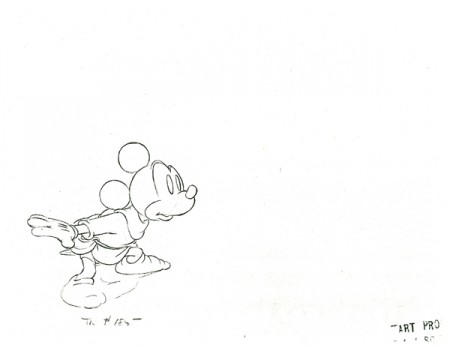 183
183(Click any image to enlarge.)
The following QT movie represents all 246 drawings of the scene.
Click left side of the black bar to play.Right side to watch single frame.
Photos 14 Mar 2010 10:10 am
Floral Photos
- The last couple of weeks has brought some pretty unfriendly weather to the New York area. The blizzard of snow we had two weekends ago had barely been washed from our streets and backyards, when we were hit with 5 inches of drenching rains and 50 mph winds this weekend. It’s still ongoing.
All this is nature’s way of saying Spring’s in the air. To celebrate (and to look at something less angry than our current street scenes) I thought it’d be appropriate to post these photos my friend, Steve Fisher, shot at the Botanical Gardens. Always a haven, the gardens are located in the Bronx just across the street from the main entrance of the Bronx Zoo. Once inside everything changes, the atmosphere quiets down and nature takes its course. Take a look at these photos, and many thanks to Steve for sharing them.
 1
1(Click any image you’d like to enlarge.)
The short break is over. Now back to the intemperate weather.
Animation &walk cycle 13 Mar 2010 08:46 am
Burness Cat
- Here’s a secondary character from the Ub Iwerk’s Flip the Frog short, The Office Boy (1932). This was animated by Pete Burness. Milt Gross’ influence is obvious. The animation industry was smitten with him – for good reason.
There’s a wonderfully loose quality to the the run that was all but lost in later animation when things got sophisticated. Today, that loose quality is dead as a doornail.
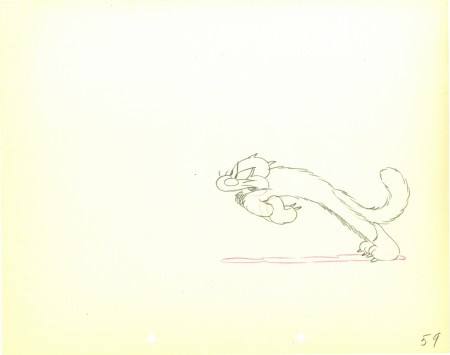
(Click any image to enlarge.)
The following QT movie represents the 20 frame cycle above on one’s.
Click left side of the black bar to play.Right side to watch single frame.
Bill Peckmann &Illustration &Rowland B. Wilson 12 Mar 2010 08:46 am
Even more Rowland B. Wilson
- I’ve dedicated a number of posts to the artwork and cartoons of Rowland B. Wilson.
I have been a fan of his work for a very long time. Years before I had the opportunity of inbetweening on his Scholastic Rock designs at Phil Kimmelman & Associates which was back in the early ’70s.
Bill Peckmann and I seem to share a lot in appreciating a number of artists and their artwork. Rowland is high on the list. Bill has loaned many works for posting, and I’m certainly indebted to him for contributing all of these RBWilson pieces.
Here are more of the cartoons of Rowland B. Wilson, starting with a news article written about him for the Westport News.
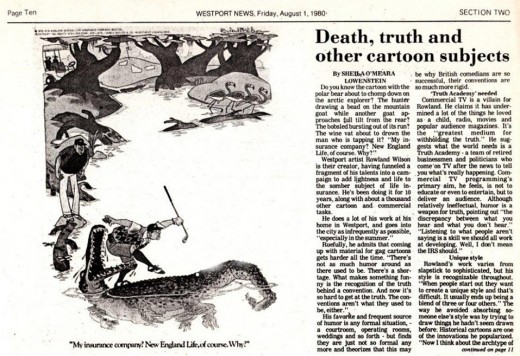
(Click any image to enlarge.)
Let’s start with the New England Life advertisements. RBW did quite a few of them:
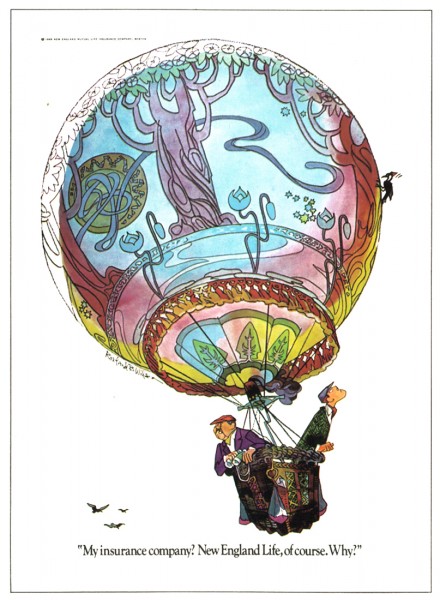 1
1
We finish this post with some more Playboy cartoons:
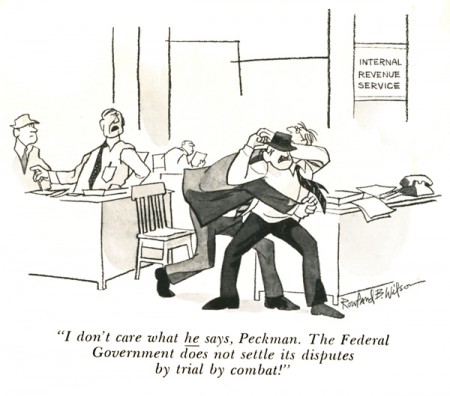
It must have been a treat for Bill to see his name in this cartoon.



